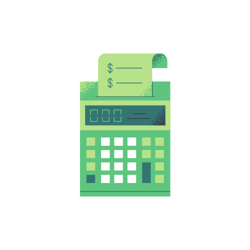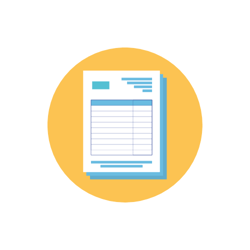How to Streamline Your Restaurant Accounting for Business Growth
Let's face it, owning a restaurant can be tough...
As you're likely aware, the restaurant industry has very tight profit margins. And that's precisely why developing an efficient and accurate restaurant accounting system is of utmost importance if you want to continue to grow your business.
A restaurant accounting process not only helps with financial reporting and overall growth planning, it also helps identify and control issues such as theft, loss of inventory, and profitability.
The unfortunate truth is that there are many challenges to streamlining your business bookkeeping process. However, a good accounting system should help you target three essential aspects of growth planning.
With over five years of experience in restaurant management and 10+ years of restaurant-specific bookkeeping experience, I have a great understanding of how a restaurant works, both from an operational standpoint and a behind-the-scenes "big picture" financial standpoint.
Here's my best advice on setting up a dialed restaurant bookkeeping process.
1. Profitability
Profitability is obviously a large part of restaurant growth planning.
There are some key elements to developing a good bookkeeping system to ensure that you are continuing to grow your business well.
In the restaurant industry, this starts with calculating overhead and adjusting pricing to target marketing.
Calculate Your Overhead
One of the most challenging steps to opening a restaurant is calculating your overhead and setting your prices.
Knowing the overhead of your restaurant before you get started can help you decide some critical things about your business, such as:
- Are you opening a restaurant in the right market?
- Can your target consumer afford the prices you will set?
- Are you going to turn a profit?
Planning and preparing before jumping into an opening can help you build a foundation for serving happy customers while keeping you afloat.
How to Calculate Overhead for a Restaurant
The term “overhead” is thrown around a lot in the business world. In short, it refers to the operational costs not related to your direct materials and labor.
Start by adding up any expense that is apart from food expenses, waiting and dish staff, and your cooking staff. Some expenses you will want to consider including:
- Marketing budget (including promotion, ads, discounts, etc.)
- Assets & their depreciation (building purchase, large equipment, vehicles for restaurant use, etc.)
- Rent or mortgage payments
- Indirect labor costs (maintenance staff, custodial service, accounting service, etc.)
- Supplies not related to food (cleaning supplies, dish detergent, etc.)
- Utilities & Bills
- Property taxes, annual licensing fees, other taxes
Overhead costs are sometimes referred to as operational costs, expenses or fixed costs.
Next, consider if your expense is fixed or variable. All of the restaurant related expenses listed above are generally given at a fixed rate. Food and labor are not included because they tend to vary by day, week, or season.
While there is some variance to the above-mentioned expenses, they are items you will be paying on a consistent basis to stay in operation.
Your electric bill may be cheaper one month and much higher another, but you will always have to pay the rate the company requires.
When it comes to food or wait staff, you will see changes in food prices often and variance in staff wages based on experience and hours.
Set Your Menu Prices
Knowing your overhead is the first step to moving forward with an effective restaurant accounting system. The next step is setting realistic menu prices that suit your market, budget, and growth planning.
In order to set your ideal menu prices, you must consider your variable costs, the market you are opening in and your unique offering.
|
For example: If you are opening a pizza shop between Pizza Hut and Dominos, you will need great prices or a unique selling point to attract business. If you are opening a 5-star, haute cuisine restaurant in a middle-class working suburb, you may not see any local patrons. |
It may seem easy to calculate menu item costs by looking at your expenses and deciding what will turn a profit. Unfortunately, pricing is more of an art than a science. The numbers matter, but your intuition does too.
Your overhead costs will need to be covered, but ultimately, your buyers will determine the price.
You may be willing to sell a cheeseburger for $20, but you will not sell it unless you find a buyer willing to pay that price. Buyers must feel they are getting as much value out of your food as they are paying for it.
While there are very specific, margin-based formulas for determining pricing, they may lead you astray. The best way to decide on what to charge is to account for the formula, plus your target buyer.
Once you have your calculations, ask yourself if your target patron will pay that price. If they will, great! Adjust accordingly if you think the price is too high or maybe too low.
You want to strike a balance between turning a profit and offering consumers a price they are willing to pay.
You must also be willing to adjust your pricing as you review your overall financial reports. Adjust to changes in the economy and demand from your clientele until you find a pricing system that works well for you and your demographic.
2. Loss Prevention
Unfortunately, one major issue restaurants face is theft. Not only do restaurant owners need to worry about employee theft, but bookkeeper theft as well. Theft can really eat into your bottom line and make your restaurant accounting into a mess.
As a restaurant bookkeeper and manager I've witnessed it all; from employees stealing drinks and food, to employees being taken out in handcuffs due to massive fraud and theft.
Use Your Restaurant P.O.S System As A Tool
If you use a point of sale (P.O.S) system for your restaurant, you need to use all the functions of the system.
Take the time to work through the proper set-up of your P.O.S. system with the programmers. Learn the system's ins and outs and figure out how best to use it for your restaurant.
Here's the deal...
Your P.O.S system can help control and minimize employee and bookkeeper theft. For example, you can program your P.O.S system to include manager approval to open a cash drawer and/or apply a discount or comp to a ticket.
Additionally, you should use your reporting to tie out cash on a daily basis. If cash doesn't tie, something is wrong.
You'll also need to understand and use certain reports from your P.O.S system, one of which is the daily sales summary report.
3. Financial Reporting
Daily Sales Summary
The daily sales summary report is an important report because it tells you everything that happened in your restaurant on a particular day; not only sales but payments and comps as well.
One of the more important things to understand on your daily sales summary is how to get that information into your accounting system so you can reconcile your accounts at the end of the month. The recording of daily sales seems simple but ends up confusing many owners and bookkeepers.
Here's the key...
You need to mirror what happens in your bank account.
Forget sales for a second, and let's talk about payments. Payments typically take the form of cash, checks, credit cards, gift cards, and comps.
Your daily sales journal entry needs to match exactly to the manner in which these funds hit your bank account. If they don't, reconciliation will prove extremely difficult.
Depending on your merchant processor, your Amex deposits most likely post to your bank account separately from your Visa/MasterCard/Discover deposits. So, you need to set up separate payment line items for each on your daily sales journal.
Now, what about cash? When does it go in the bank? Is it when your customer pays you and you put the cash in the cash register?
No!
It's when that cash is taken to the bank.
Pro Tip: What I recommend is keeping your cash register at a pre-set amount and having a manager tie out cash every night to your reports. Then I would deposit cash payments for a particular date range to the penny with one deposit slip for each day.
Handling cash payments is a good example of what the undeposited funds feature in QuickBooks was built for.
If your P.O.S. system doesn't come with a daily sales summary that breaks out payments as you need them, you need to develop a custom report or have your restaurant bookkeeper create one for you.
Otherwise, your accounting system will not be accurate, and you won't be able to reconcile your bank accounts!
As you grow into multiple restaurant locations, having this daily sales system in place will prove invaluable.
Importable Payroll Data
Payroll can be a massive pain for your restaurant or restaurant group. When planning for business growth, it is necessary to delegate out tasks to ensure that all steps are being properly accounted for.
Depending on the number of employees, payroll can become a huge burden to account for properly.
You need to record payroll-related issues by gross pay, employee payroll liabilities, and employer taxes at the very least!
I have three major recommendations regarding payroll for your restaurant.
First, set up separate checking accounts for payroll. While I don't think having a separate bank account for payroll is mandatory, I have found it very helpful.
Second, outsource your payroll. I recommend outsourcing your payroll for just about any type of business. For the minimal cost, you would be hard-pressed to find a bookkeeper or accountant who can do it cheaper in-house.
Finally, have your payroll data importable into your accounting system. Having payroll data that can be imported into your accounting system is absolutely crucial. Too many restaurants record payroll checks for the net amount as payroll expenses and call it good. There are so many issues with this, and one of those is either understating or overstating expenses.
Inputting payroll correctly into your accounting system through data entry is time consuming, costly and often inaccurate due to human error.
Develop an Accounts Payable System
Developing an accounts payable system for your restaurant in the early stages of the business is important before things become too complicated.
If you have multiple locations for your restaurant group you may want to consider using the QuickBooks class feature to account for the expenses of each location.
Let me ask you this...
How often do you need to input bills so that you are looking at accurate expense reports?
How often do you need to pay bills to keep your vendors happy?
Here's a tip...
A huge time saver is linking your accounting system to your bank and enabling bill payment through that same system. This will allow you to approve and pay bills directly through your accounting system.
Your banking institution will then automatically send a payment to your vendor without you having to cut a check, put it in an envelope, and put postage on it.
This simple trick can save you both time and money!
The most important thing with your AP system is to develop a clear and consistent process that keeps your vendors happy and your reporting updated enough to satisfy the restaurant owners and investors.
Restaurant Accounting Reporting System
I can't say this any more bluntly...
Restaurant reporting is crucial to the success of your business.
You must develop a set of reports you can review on a regular basis.
You may need to look at some reports every day or every week, while others you only need to review once a month or quarter. Whatever the case, it's important to review your reports consistently.
Of course, you also need to be sure you're looking at accurate information. And the only way to ensure the information is accurate is to ensure all of your accounts have been reconciled.
What's the best way to do this?
All of the steps we just talked about need to be carried out accurately, in a timely manner, and in order, for your restaurant reporting to be error-free.
Here's a quick recap...
- Calculate your overhead by considering your fixed and variable expenses.
- Use that information to create realistic menu prices. Adjust accordingly.
- Use your P.O.S. System to reduce theft and also streamline accounting.
- Implement a daily sales journal entry.
- Develop an AP system and a way to get your payroll data inputted accurately.
If all of these steps are carried out correctly, you can reconcile all your accounts. Once your accounts have been reconciled, you can be sure you are looking at accurate reports.
Friends, do yourself a favor and develop an efficient restaurant reporting system and reporting schedule that works for you.
Good reporting procedures will keep your restaurant on track and profitable!
Like many businesses, I feel the most important part of the restaurant bookkeeping process is reconciling. Account reconciliation is only possible if all the steps in the process are carried out efficiently and accurately.
The biggest hang-up I typically see with restaurants is getting the daily sales summary report into a format that allows for bank reconciliation.
If you record all credit card payments as one lump sum you will soon find out that reconciling your bank account is impossible.
As you can see, there are some tricky curves to be navigated when it comes to restaurant bookkeeping.




Comments